Distribution of Radionuclides and Radiological Health Assessment in Seih-Sidri Area, Southwestern Sinai
Abstract
:1. Introduction
2. Materials and Methods
2.1. Sample Processing
2.2. Activity Measurements (NaI (Tl) Detector)
- Equipment processing using reference gamma emission sources (137Cs and 57Cs) for lead energy calibration shield.
- Test samples for 1000 s for each one, in a protected environment and design the total numbers of U, Th, eU (Ra), and K they have Selected energy zones as well.
- The background spectra were used to modify the net peak area of gamma rays for the measured isotopes. Background count rates in specific energy regions (ROIs) for the laboratory with a detector. The assessment time for activity or background was the same.
- Computer “analysis” Canberra software was used to process recorded spectral data (total number of U, Th, Ra, and K) for each sample, determining the U, Th, and Ra mass fractions in mg/kg and the potassium mass fraction in percentage using background count rates, sample weight, measurement time, and initial sensitivity constants (percent). For low and medium-grade samples, the lowest detection limit for U is 2 mg/kg, while the maximum one is 2000 mg/kg. Limits of detection for raw granite samples exceed 2 percent. Uranium-specific activity uncertainty is between 10 and 15 percent. The inaccuracy is anticipated to range from 1 to 5 percent, while the minimum detection level for thorium is 0.6 mg/kg. Radium detection threshold of 0.4 mg/kg. The Ra estimated error percentages range from 1 to 5 percent. The precision of the energy calibration approach, which takes into account the likely interference of each nuclide in each peak site, and the estimated error of 1 to 5 decide the findings [30,31,32,33]. The minimal detection K is 0.1 percent. The gamma-ray spectrometry system consists of a scintillation (Bicron) detector with a 76 mm × 76 mm NaI (Tl) crystal that is hermetically sealed with a photomultiplier tube in an aluminum container. The detector is fastened to the “Accuspec card” and covered with its amplifier in a cylindrical lead chamber and a shield of copper with a thickness of 0.6 cm against induced X-rays. The Accuspec NaI detector with a 2K onboard ADC, Amp, and HVPS with a 2K channel memory is linked to a PC. By choosing four energy regions of interest (ROIs) for U, Th, Ra, and K, which correspond to 234Th, 212Pb, 214Pb, and 40K, respectively, the radionuclides are measured. Thorium is measured in eTh, whereas uranium is measured in U and Ra (U). The U values estimate the first daughter isotope in the 238U decay chain with the least amount of loss by utilizing the 234Th energy peak (93 keV) to reflect the mass fraction of U. When 238U and all of its daughter isotopes reach secular equilibrium, which takes place when the daughters’ rate of decay equals the parent’s one after four weeks, radium is measured at the 214Pb peak of 352 keV energy, which is tied to a measure for the mass fraction of the U. Thorium is found in the Pb-212 peak, which has an energy of 238 keV [31,34,35].
2.3. Energy and Efficiency Calibration
3. Results and Discussion
3.1. Geological Setting
3.2. Radioactivity and Radiometric Prospecting
4. Conclusions
Author Contributions
Funding
Institutional Review Board Statement
Informed Consent Statement
Data Availability Statement
Acknowledgments
Conflicts of Interest
References
- Zare, M.R.; Mostajaboddavati, M.; Kamali, M.; Abdi, M.R.; Mortazavi, M.S. 235U, 238U, 232Th, 40K and 137Cs Activity Concentrations in Marine Sediments along the Northern Coast of Oman Sea Using High-Resolution Gamma-Ray Spectrometry. Mar. Pollut. Bull. 2012, 64, 1956–1961. [Google Scholar] [CrossRef] [PubMed]
- Zakaly, H.M.H.; Uosif, M.A.; Issa, S.; Saif, M.; Tammam, M.; El-Taher, A. Estimate the Absolute Efficiency by MATLAB for the NaI (Tl) Detector Using IAEA-314. AIP Conf. Proc. 2019, 2174, 20248. [Google Scholar] [CrossRef]
- Zaim, N.; Tugrul, A.B.; Atlas, H.; Buyuk, B.; Demir, E.; Baydogan, N.; Altinsoy, N. Investigation of Natural Radioactivity of Surface Soil Samples in the Vicinity of Edirne-Turkey. Acta Phys. Polonica A 2016, 130, 64–67. [Google Scholar] [CrossRef]
- Ribeiro, F.C.A.; Silva, J.I.R.; Lima, E.S.A.; do Amaral Sobrinho, N.M.B.; Perez, D.V.; Lauria, D.C. Natural Radioactivity in Soils of the State of Rio de Janeiro (Brazil): Radiological Characterization and Relationships to Geological Formation, Soil Types and Soil Properties. J. Environ. Radioact. 2018, 182, 34–43. [Google Scholar] [CrossRef] [PubMed]
- Öztürk, B.C.; Çam, N.F.; Yaprak, G. Reference Levels of Natural Radioactivity and 137Cs in and around the Surface Soils of Kestanbol Pluton in Ezine Region of Çanakkale Province, Turkey. J. Environ. Sci. Health Part A Toxic/Hazard. Subst. Environ. Eng. 2013, 48, 1522–1532. [Google Scholar] [CrossRef]
- Zakaly, H.M.H.; Uosif, M.A.M.; Issa, S.A.M.; Tekin, H.O.; Madkour, H.; Tammam, M.; El-Taher, A.; Alharshan, G.A.; Mostafa, M.Y.A. An extended assessment of natural radioactivity in the sediments of the mid-region of the Egyptian Red Sea coast. Mar. Pollut. Bull. 2021, 171, 112658. [Google Scholar] [CrossRef]
- Günay, O.; Eke, C. Determination of Terrestrial Radiation Level and Radiological Parameters of Soil Samples from Sariyer-Istanbul in Turkey. Arab. J. Geosci. 2019, 12, 1–10. [Google Scholar] [CrossRef]
- Aközcan, S. Annual Effective Dose of Naturally Occurring Radionuclides in Soil and Sediment. Toxicol. Environ. Chem. 2014, 96, 379–386. [Google Scholar] [CrossRef]
- El-Taher, A.; Zakaly, H.M.H.; Elsaman, R. Environmental Implications and Spatial Distribution of Natural Radionuclides and Heavy Metals in Sediments from Four Harbours in the Egyptian Red Sea Coast. Appl. Radiat. Isot. 2018, 131, 13–22. [Google Scholar] [CrossRef]
- UNSCEAR. Sources and Effects of Ionizing Radiation United Nations Scientific Committee on the Effects of Atomic Radiation; United Nations: New York, NY, USA, 2010; Volume I, ISBN 9789211422740. [Google Scholar]
- Abbasi, A.; Mirekhtiary, F. Heavy Metals and Natural Radioactivity Concentration in Sediments of the Mediterranean Sea Coast. Mar. Pollut. Bull. 2020, 154, 111041. [Google Scholar] [CrossRef]
- Abbasi, A.; Zakaly, H.M.H.; Mirekhtiary, F. Baseline levels of natural radionuclides concentration in sediments East coastline of North Cyprus. Mar. Pollut. Bull. 2020, 161, 111793. [Google Scholar] [CrossRef] [PubMed]
- El Rakaiby, M.L.; Shalaby, M.H. Geology of Gebel Qattar Batholith, Central Eastern Desert, Egypt. Int. J. Remote Sens. 1992, 13, 2337–2347. [Google Scholar] [CrossRef]
- Heikal, M.T.S.; Top, G. Assessment of Radioactivity Levels and Potential Radiation Health Hazards of Madsus Granites and Associated Dikes Nearby and around Ruwisat Village, South Sinai, Egypt. J. Afr. Earth Sci. 2018, 146, 191–208. [Google Scholar] [CrossRef]
- Ramadan, R.S.; Dawood, Y.H.; Yehia, M.M.; Gad, A. Environmental and Health Impact of Current Uranium Mining Activities in Southwestern Sinai, Egypt. Environ. Earth Sci. 2022, 81, 213. [Google Scholar] [CrossRef]
- Omar, A.; Arnous, M.; El-Ghawaby, M.; Alshami, A.; El Zalaky, M. Seismotectonic hazards assessment in Southwestern Sinai area using Remote sensing and GIS. Sinai J. Appl. Sci. 2016, 5, 427–442. [Google Scholar] [CrossRef]
- Sultan, Y.M.; El-Shafei, M.K.; Arnous, M.O. Tectonic Evolution of Kid Metamorphic Complex and the Recognition of Najd Fault System in South East Sinai, Egypt. Int. J. Earth Sci. 2017, 106, 2817–2836. [Google Scholar] [CrossRef]
- Awad, H.A.; El-Leil, I.A.; Nastavkin, A.V.; Tolba, A.; Kamel, M.; El-Wardany, R.M.; Rabie, A.; Ene, A.; Tekin, H.O.; Issa, S.A.M.; et al. Statistical Analysis on the Radiological Assessment and Geochemical Studies of Granite Rocks in the North of Um Taghir Area, Eastern Desert, Egypt. Open Chem. 2022, 20, 254–266. [Google Scholar] [CrossRef]
- Lasheen, E.S.R.; Saleh, G.M.; Khaleal, F.M.; Alwetaishi, M. Petrogenesis of Neoproterozoic Ultramafic Rocks, Wadi Ibib–Wadi Shani, South Eastern Desert, Egypt: Constraints from Whole Rock and Mineral Chemistry. Appl. Sci. 2021, 11, 10524. [Google Scholar] [CrossRef]
- Hamdy, M.M.; Lasheen, E.S.R.; Abdelwahab, W. Gold-Bearing Listwaenites in Ophiolitic Ultramafics from the Eastern Desert of Egypt: Subduction Zone-Related Alteration of Neoproterozoic Mantle? J. Afr. Earth Sci. 2022, 193, 104574. [Google Scholar] [CrossRef]
- Saleh, G.M.; Khaleal, F.M.; Lasheen, E.S.R. Geochemistry and Paleoweathering of Metasediments and Pyrite-Bearing Quartzite during the Neoproterozoic Era, Wadi Ibib-Wadi Suwawrib, South Eastern Desert, Egypt. Arab. J. Geosci. 2022, 15, 1–27. [Google Scholar] [CrossRef]
- Alzahrani, A.M.; Lasheen, E.S.R.; Rashwan, M.A. Relationship of Mineralogical Composition to Thermal Expansion, Spectral Reflectance, and Physico-Mechanical Aspects of Commercial Ornamental Granitic Rocks. Materials 2022, 15, 2041. [Google Scholar] [CrossRef] [PubMed]
- Kamar, M.S.; Salem, I.A.; El-Aassy, I.E.; El-Sayed, A.A.; Awad, H.A.; Tekin, H.O.; Alzahrai, A.M.; Lasheen, E.S.R. Petrology and Geochemistry of Multiphase Post-Granitic Dikes: A Case Study from the Gabal Serbal Area, Southwestern Sinai, Egypt. Open Chem. 2022, 20, 169–181. [Google Scholar] [CrossRef]
- Khaleal, F.M.; Saleh, G.M.; Lasheen, E.S.R.; Alzahrani, A.M.; Kamh, S.Z. Exploration and Petrogenesis of Corundum-Bearing Pegmatites: A Case Study in Migif-Hafafit Area, Egypt. Front. Earth Sci. 2022, 10, 869828. [Google Scholar] [CrossRef]
- Stern, R.J.; Hedge, C.E. Geochronologic and Isotopic Constraints on Late Precambrian Crustal Evolution in the Eastern Desert of Egypt. Am. J. Sci. 1985, 285, 91–127. [Google Scholar] [CrossRef]
- Moussa, H.E.; Asimow, P.D.; Azer, M.K.; Abou El Maaty, M.A.; Akarish, A.I.M.; Yanni, N.N.; Mubarak, H.S.; Wilner, M.J.; Elsagheer, M.A. Magmatic and Hydrothermal Evolution of Highly-Fractionated Rare-Metal Granites at Gabal Nuweibi, Eastern Desert, Egypt. Lithos 2021, 400, 106405. [Google Scholar] [CrossRef]
- Awad, H.A.M.; Zakaly, H.M.H.; Nastavkin, A.V.; El-Taher, A. Radioactive Content and Radiological Implication in Granitic Rocks by Geochemical Data and Radiophysical Factors, Central Eastern Desert, Egypt. Int. J. Environ. Anal. Chem. 2020, 1–14. [Google Scholar] [CrossRef]
- Hans Wedepohl, K. The composition of the continental crust. Geochim. Cosmochim. Acta 1995, 59, 1217–1232. [Google Scholar] [CrossRef]
- Rudnick, R.L.; Gao, S. Composition of the Continental Crust. In Treatise on Geochemistry, 2nd ed.; Elsevier Ltd.: Amsterdam, The Netherlands, 2014; Volume 4, pp. 1–51. [Google Scholar] [CrossRef]
- Chiozzi, P.; De Felice, P.; Fazio, A.; Pasquale, V.; Verdoya, M. Laboratory Application of NaI(Tl) γ-Ray Spectrometry to Studies of Natural Radioactivity in Geophysics. Appl. Radiat. Isot. 2000, 53, 127–132. [Google Scholar] [CrossRef]
- Zakaly, H.M.; Uosif, M.A.; Madkour, H.; Tammam, M.; Issa, S.; Elsaman, R.; El-Taher, A. Assessment of Natural Radionuclides and Heavy Metal Concentrations in Marine Sediments in View of Tourism Activities in Hurghada City, Northern Red Sea, Egypt. J. Phys. Sci. 2019, 30, 21–47. [Google Scholar] [CrossRef]
- Awad, H.A.; Zakaly, H.M.H.; Nastavkin, A.V.; El Tohamy, A.M.; El-Taher, A. Radioactive Mineralizations on Granitic Rocks and Silica Veins on Shear Zone of El-Missikat Area, Central Eastern Desert, Egypt. Appl. Radiat. Isot. 2021, 168, 109493. [Google Scholar] [CrossRef]
- Moghazy, N.M.; El-Tohamy, A.M.; Fawzy, M.M.; Awad, H.A.; Zakaly, H.M.H.; Issa, S.A.M.; Ene, A. Natural Radioactivity, Radiological Hazard and Petrographical Studies on Aswan Granites Used as Building Materials in Egypt. Appl. Sci. 2021, 11, 6471. [Google Scholar] [CrossRef]
- Lasheen, E.S.R.; Rashwan, M.A.; Osman, H.; Alamri, S.; Khandaker, M.U.; Hanfi, M.Y. Radiological Hazard Evaluation of Some Egyptian Magmatic Rocks Used as Ornamental Stone: Petrography and Natural Radioactivity. Materials 2021, 14, 7290. [Google Scholar] [CrossRef] [PubMed]
- Lasheen, E.S.R.; Azer, M.K.; Ene, A.; Abdelwahab, W.; Zakaly, H.M.H.; Awad, H.A.; Kawady, N.A. Radiological Hazards and Natural Radionuclide Distribution in Granitic Rocks of Homrit Waggat Area, Central Eastern Desert, Egypt. Materials 2022, 15, 4069. [Google Scholar] [CrossRef] [PubMed]
- Awad, H.A.; Zakaly, H.M.H.; Nastavkin, A.V.; El-Taher, A. Radioactive content in the investigated granites by geochemical analyses and radiophysical methods around Um Taghir, Central Eastern Desert, Egypt. J. Phys. Conf. Ser. 2020, 1582, 12007. [Google Scholar] [CrossRef]
- Tawfic, A.F.; Zakaly, H.M.H.; Awad, H.A.; Tantawy, H.R.; Abbasi, A.; Abed, N.S.; Mostafa, M. Natural radioactivity levels and radiological implications in the high natural radiation area of Wadi El Reddah, Egypt. J. Radioanal. Nucl. Chem. 2021, 327, 643–652. [Google Scholar] [CrossRef]
- Kamar, M.S. Potentiality of Nuclear Elements in Seih-Sidri Area, Southwestern Sinai-Egypt. Master’s Thesis, Mansoura University, Mansoura, Egypt, 2006. [Google Scholar]
- El- Sayed, A.A.; El-Aassy, I.E.; El-Metwally, A.A.; Kamar, M.S. Syenogranites and associated pegmatites of Seih sidri area, southwestern sinai, Egypt: Petrographical, geochemical and radioactive characteristics. Fifth Int. Conf. Geol. Afr. 2007, 1, 29–42. [Google Scholar]
- Kamar, M.S.; Salem, I.A.; El-Aassy, I.E.; El-Sayed, A.A.; Rezk, A.A.; Saleh, G.M. Contribution to the Geological, Geochemical and Mineralogical Studies of Gabal Serbal Granitic Rocks, Southwestern Sinai, Egypt. Int. J. Min. Sci. 2021, 7, 29–52. [Google Scholar] [CrossRef]
- European Commission (EC). Radiological Protection Principles Concerning the Natural Radioactivity of Building Materials-Radiation Protection 112; European Commission: Brussels, Belgium, 1999; pp. 1–16. [Google Scholar]
- Nada, A. Evaluation of Natural Radionuclides at Um-Greifat Area, Eastern Desert of Egypt. Appl. Radiat. Isot. 2003, 58, 275–280. [Google Scholar] [CrossRef]
- Uosif, M.A.M.; El-taher, A. Radiological Assessment of Abu-Tartur Phosphate, Western Desert Egypt. Radiat. Prot. Dosim. 2008, 130, 228–235. [Google Scholar] [CrossRef]
- Abed, N.S.; Monsif, M.A.; Zakaly, H.M.H.; Awad, H.A.; Hessien, M.M.; Yap, C.K. Assessing the radiological risks associated with high natural radioactivity of microgranitic rocks: A case study in a northeastern desert of Egypt. Int. J. Environ. Res. Public Health 2022, 19, 473. [Google Scholar] [CrossRef]
- Saudi, H.A.; Abedelkader, H.T.; Issa, S.A.M.; Diab, H.M.; Alharshan, G.A.; Uosif, M.A.M.; Bashter, I.I.; Ene, A.; Ghazaly, M.E.; Zakaly, H.M.H. An In-Depth Examination of the Natural Radiation and Radioactive Dangers Associated with Regularly Used Medicinal Herbs. Int. J. Environ. Res. Public Health 2022, 19, 8124. [Google Scholar] [CrossRef] [PubMed]
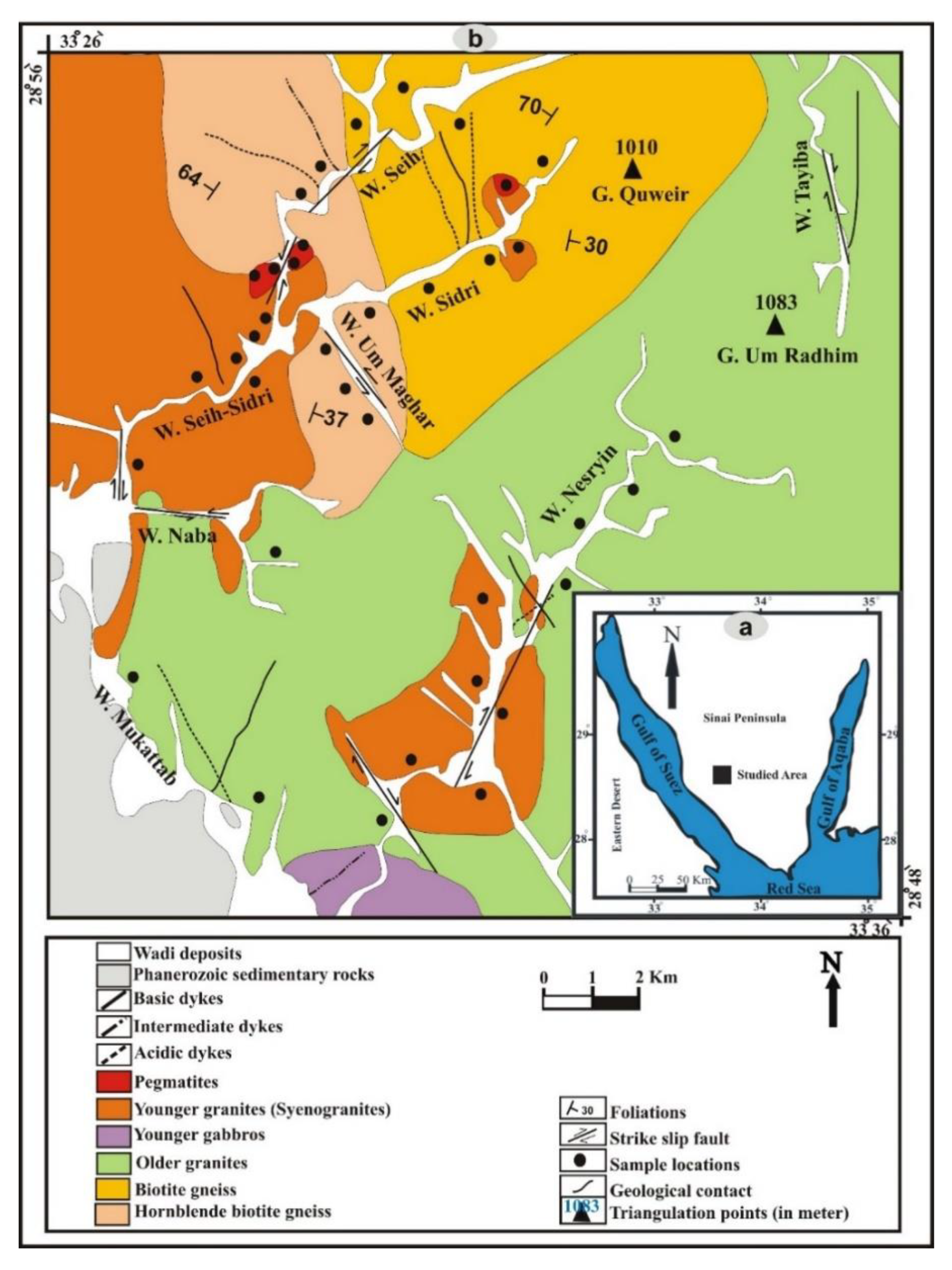
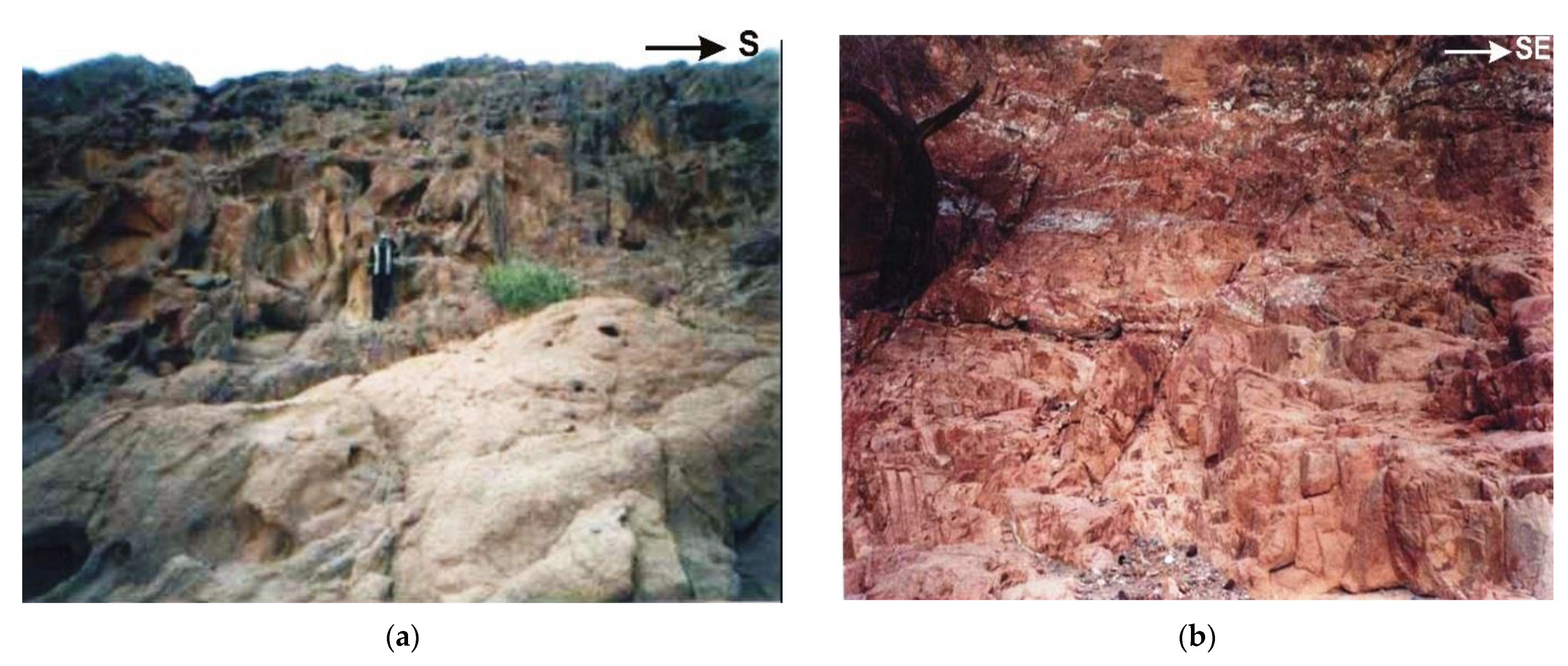


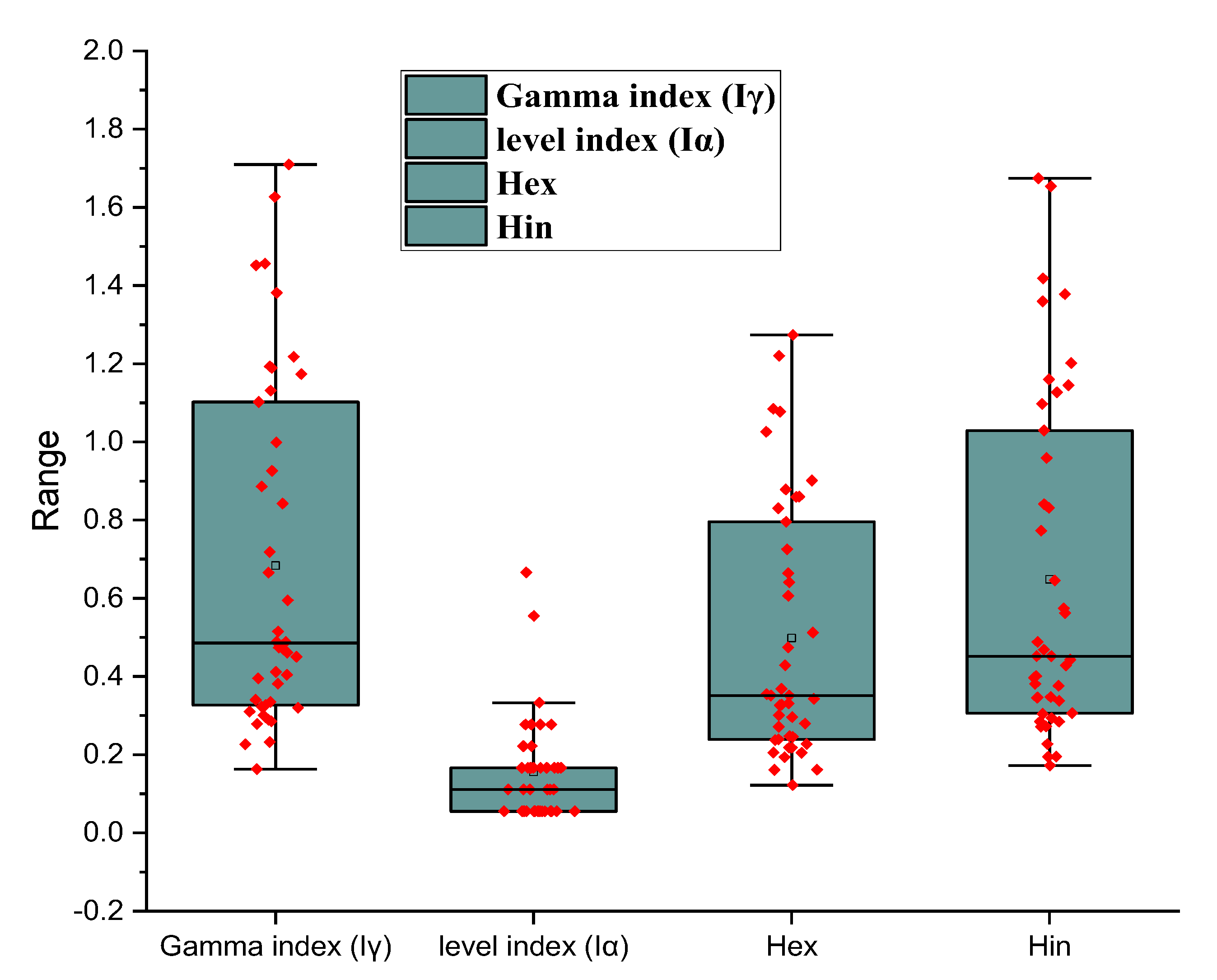

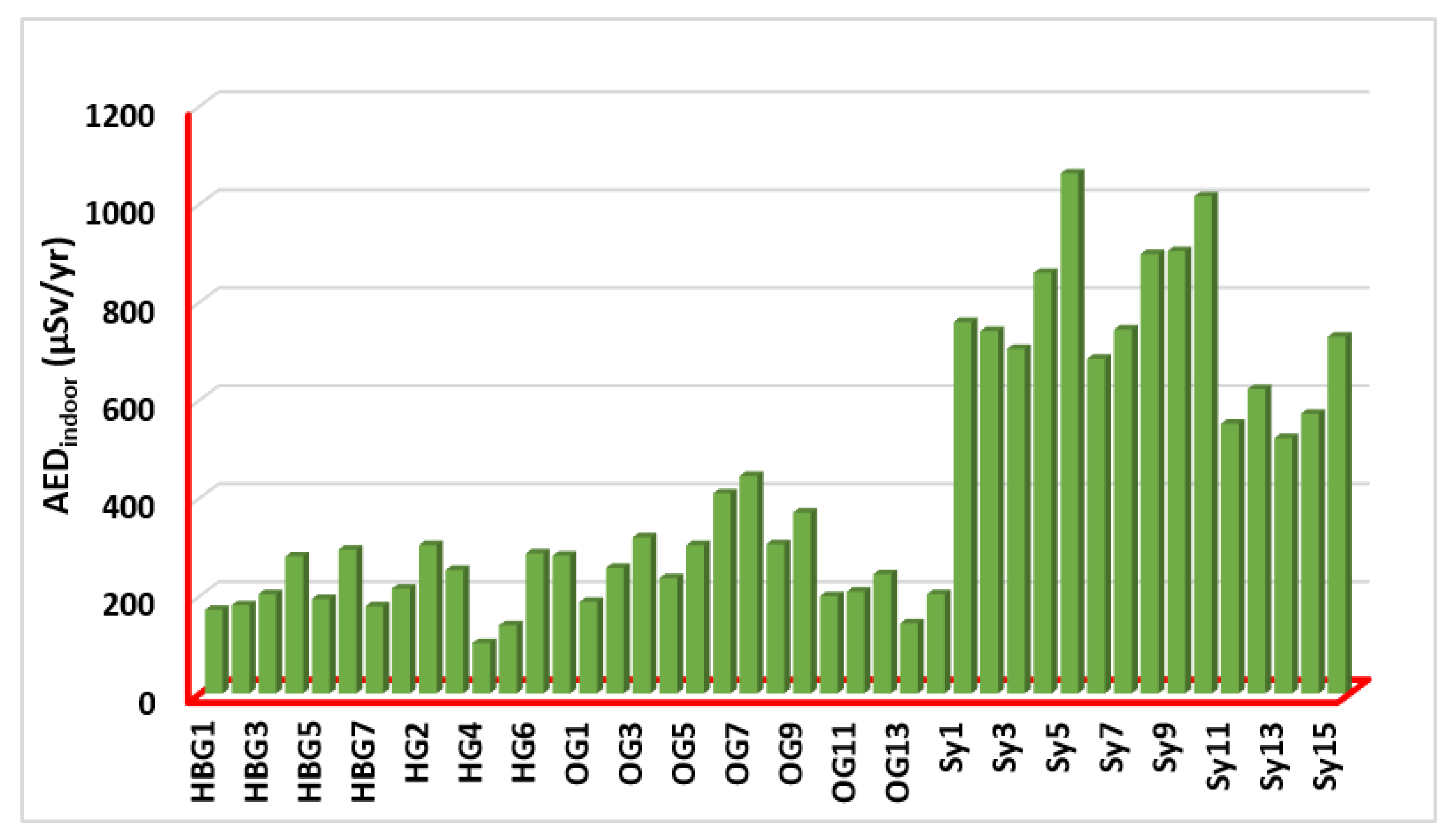
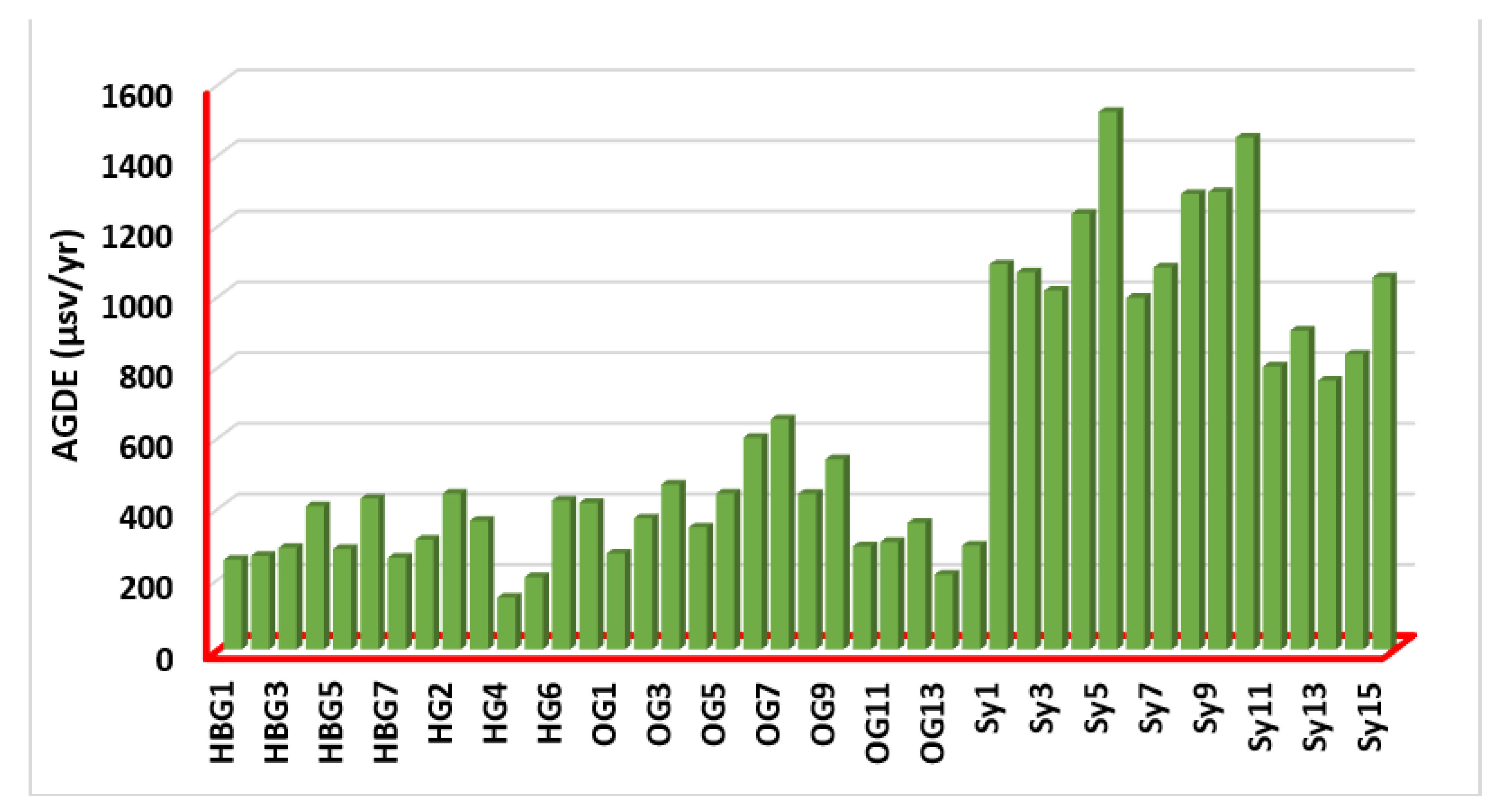
| Rock Units | Activity | 238U (mg/kg) | 232Th (mg/kg) | 226Ra (mg/kg) | 40K (%) | 232Th/238U |
|---|---|---|---|---|---|---|
| Hornblende Biotite Gneisses | Average | 2.3 | 5.3 | 1.3 | 1.4 | 2.4 |
| Min | 1.0 | 3.0 | 1.0 | 0.6 | 1.5 | |
| Max | 3.0 | 8.0 | 2.0 | 1.8 | 4.0 | |
| Biotite Gneisses | Average | 2.1 | 6.3 | 1.3 | 1.5 | 3.5 |
| Min | 1.0 | 3.0 | 1.0 | 0.4 | 1.3 | |
| Max | 3.0 | 9.0 | 3.0 | 2.2 | 6.0 | |
| Older Granites | Average | 2.6 | 6.9 | 2.0 | 1.8 | 2.7 |
| Min | 1.0 | 3.0 | 1.0 | 1.1 | 1.8 | |
| Max | 4.0 | 12.0 | 3.0 | 3.2 | 4.0 | |
| Syenogranites | Average | 8.4 | 23.6 | 5.0 | 3.8 | 2.8 |
| Min | 5.0 | 14.0 | 3.0 | 3.4 | 1.8 | |
| Max | 13.0 | 38.0 | 12.0 | 4.7 | 3.8 |
Publisher’s Note: MDPI stays neutral with regard to jurisdictional claims in published maps and institutional affiliations. |
© 2022 by the authors. Licensee MDPI, Basel, Switzerland. This article is an open access article distributed under the terms and conditions of the Creative Commons Attribution (CC BY) license (https://creativecommons.org/licenses/by/4.0/).
Share and Cite
Alharshan, G.A.; Kamar, M.S.; Lasheen, E.S.R.; Ene, A.; Uosif, M.A.M.; Awad, H.A.; Issa, S.A.M.; Zakaly, H.M.H. Distribution of Radionuclides and Radiological Health Assessment in Seih-Sidri Area, Southwestern Sinai. Int. J. Environ. Res. Public Health 2022, 19, 10717. https://doi.org/10.3390/ijerph191710717
Alharshan GA, Kamar MS, Lasheen ESR, Ene A, Uosif MAM, Awad HA, Issa SAM, Zakaly HMH. Distribution of Radionuclides and Radiological Health Assessment in Seih-Sidri Area, Southwestern Sinai. International Journal of Environmental Research and Public Health. 2022; 19(17):10717. https://doi.org/10.3390/ijerph191710717
Chicago/Turabian StyleAlharshan, Gharam A., Mohamed S. Kamar, El Saeed R. Lasheen, Antoaneta Ene, Mohamed A. M. Uosif, Hamdy A. Awad, Shams A. M. Issa, and Hesham M. H. Zakaly. 2022. "Distribution of Radionuclides and Radiological Health Assessment in Seih-Sidri Area, Southwestern Sinai" International Journal of Environmental Research and Public Health 19, no. 17: 10717. https://doi.org/10.3390/ijerph191710717
APA StyleAlharshan, G. A., Kamar, M. S., Lasheen, E. S. R., Ene, A., Uosif, M. A. M., Awad, H. A., Issa, S. A. M., & Zakaly, H. M. H. (2022). Distribution of Radionuclides and Radiological Health Assessment in Seih-Sidri Area, Southwestern Sinai. International Journal of Environmental Research and Public Health, 19(17), 10717. https://doi.org/10.3390/ijerph191710717











